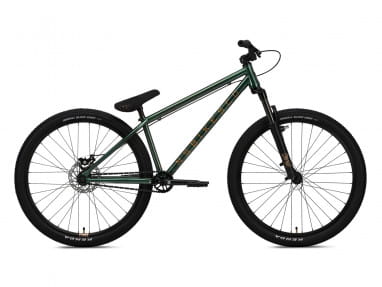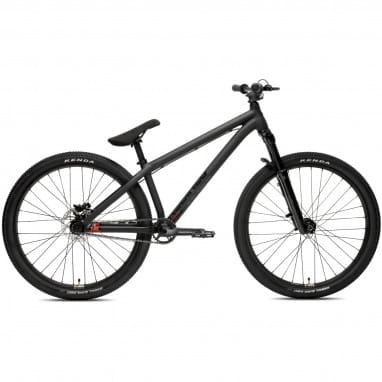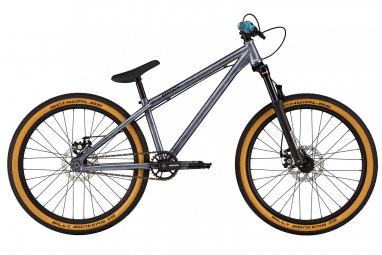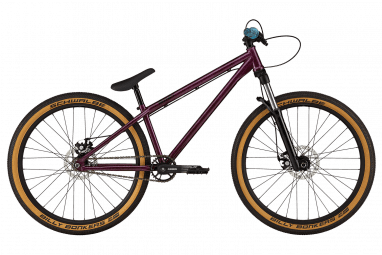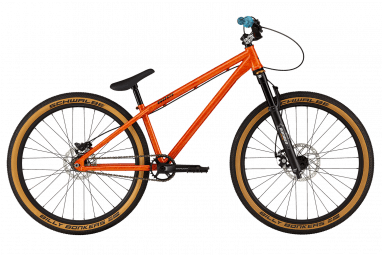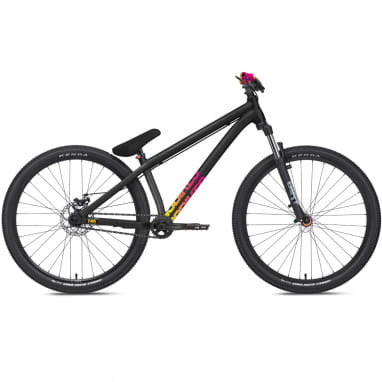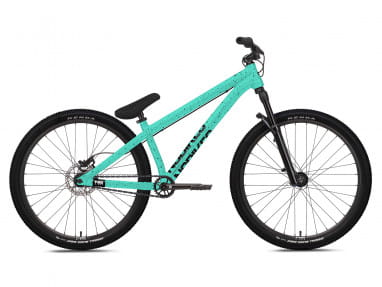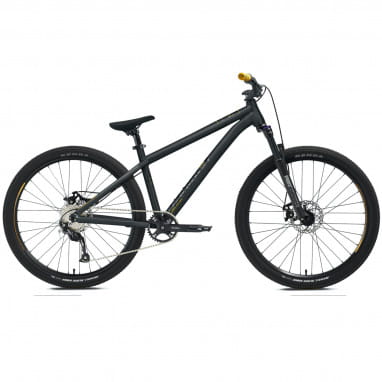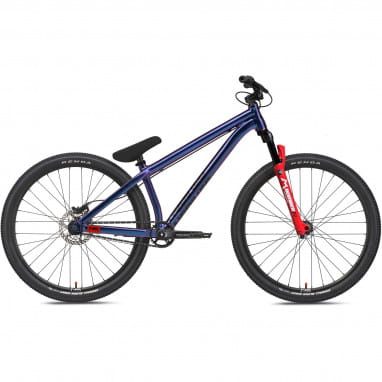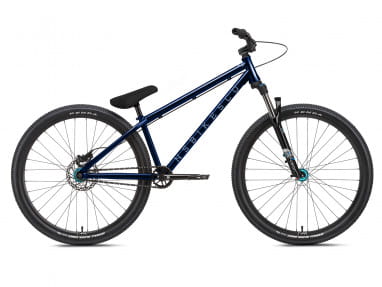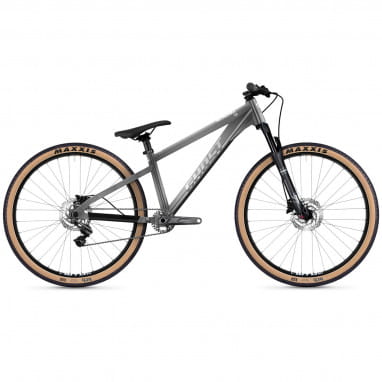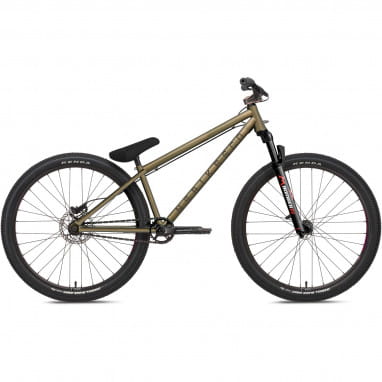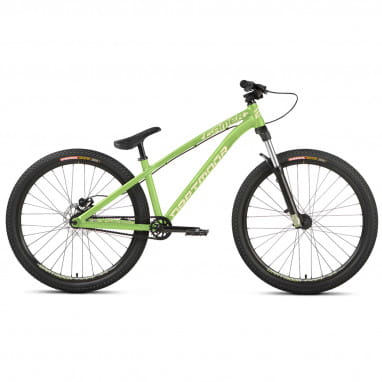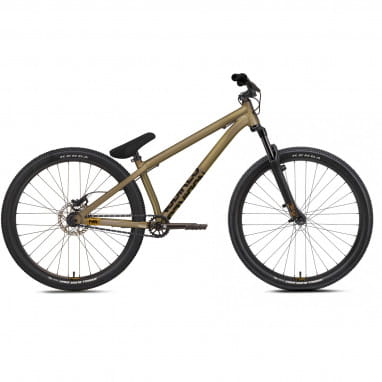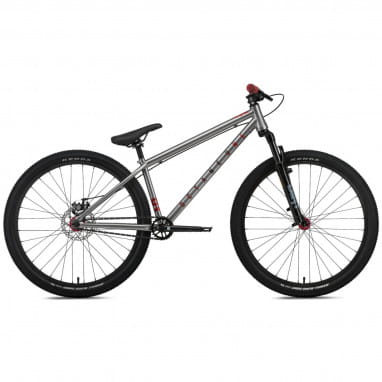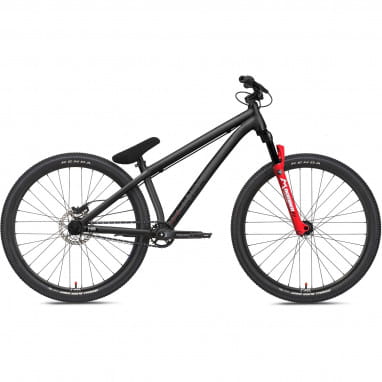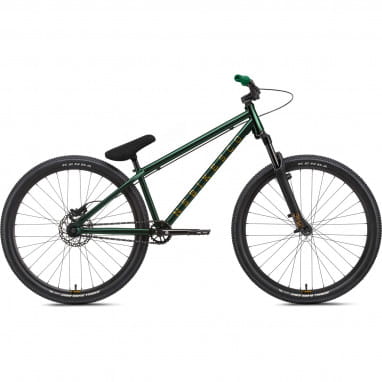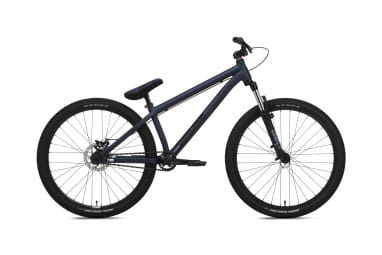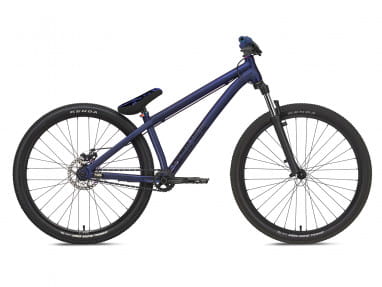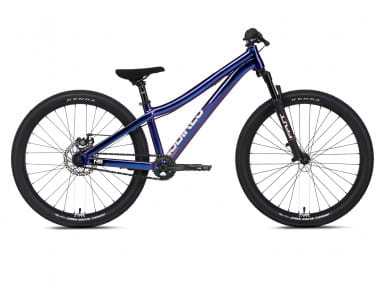Actually, a dirt bike is the evolution of a mountain bike. Or is it more of a regression, i.e. "back to the roots"? Many see in the compact fun machines also simply a cross between BMX and Trailbike. One thing's for sure, though: where a mountain bike stops on the terrain, a dirt bike will still go a long way. It may not be a classic mile-eater, but no other bike will let you conquer rocks, fallen logs, stairs, pipes, or pump tracks with as much adrenaline and action. The bottom line is that a dirt bike is at home anywhere bikes don't really belong, because they tend to be impractical in traffic.
Typical dirt bike terrain are:
- Bike parks
- Fun/skate parks (if allowed)
- Nature and rough terrain
- In town, off the beaten path, "lost places"
The shortcut:
This is a dirt bike - Things to know about dirt bikes
Since you've found your way this far, you probably already have a rough idea of what a dirt bike is and what it can do. Just to be on the safe side, here's a recount of the most important features:
Dirt Bike Basics - No Nonsense Across the Board
A dirt bike absolutely needs a sturdy frame and a set of agile wheels, but that's almost it. You can either buy dirt bike frames in aluminum versions or get a bike made of absolutely indestructible steel.
Typical of a dirtbike is the low-set top tube and the saddle, which is thus at about knee height.
The Geo just isn't made for bigger rides, unless you want to ride standing up for miles on end. You'll have noticed from our pictures that the saddle is mounted so that it's out of your way on jumps, but an efficient riding position just doesn't come out of it.
The tires of a dirt bike
Most dirt bikes stand on grippy 26 inch wheels, a good compromise between agility and speed. However, to give the offspring a taste for it in time, there are also some models with 24 inch tires for kids. Due to the relatively large tires - compared to the BMX bike - a dirt bike makes a little more distance than a BMX can. The tires are usually fitted with decent lugs, so if your dirt bike is allowed to really dirt tank, it will have plenty of bite. You can, however, also put on smooth flaps, then it will roll a bit more efficiently in the city.
Dirt bike components - balling without the fuss
Dirt bikes save material at all ends! Fat brake systems? No way - if you brake, you're scared! Thick gears with massive gears? You can get them elsewhere, but not on a dirt bike. A comfy saddle with dropper post? Forget it. A suspension fork with generous travelis the only concession to ride comfort and it needs to be able to take a decent beating, as does the crank. Why? You can tell at first glance, the bikes geometry is not made to sit out the ride. You ride, jump and fall standing up, so cranks that can sustain a lot of weight are an absolute must. The same goes for the suspension fork, which gets a lot of punishment from all the air acrobatics, so the manufacturers of our dirt bikes only use top material for the forks.
Lightweight and tough
To save weight, manufacturers like NS Bikes rely on a biting disc brake at the rear - and that's where the equipment list ends. Depending on the model, even a front brake is dispensed with completely. The clear advantage of so much minimalism is the price - you don't have to pay for what's not on the bike, and so Dirt Jump bikes deliver tremendous riding fun for relatively little money. Plus, there's no danger of valuable attachments getting overwhelmed with so much action and needing constant maintenance, repair and replacement. The only thing you have to worry about is your next ride - not your gear.
Special edition Slopestyler
The exception is slopestylers, a subspecies of mud bikes. Here a full suspension with suspension fork and frame shock is on board, which is then responsible for "higher, further, better", at least as far as the jumping ability of dirtbikes with shocks is concerned.
The bottom line is that dirtbikes are more of a gimmick than a means of transportation. They fall somewhere between BMX and MTB.
Is a dirtbike the right bike for you?
There are certainly dirt bikers who ride long distances on their bikes. We tip our hats to you guys! Without a seat (at least the saddle isn't in an anatomically sensible place) and with the small tires, it takes a lot of determination to do that. Actually, a dirt bike is not made for that. Cruising for miles through the countryside is at least not its core competence. It holds all the trump cards when it comes to "action on the spot". If you want to practice wild jumps at the skate park, rip nasty stunts on the pump track, and overall enjoy plenty of airtime, treat yourself to a dirt bike!
Dirt Bike Features at a Glance:
- As light as possible, good flying characteristics
- A sturdy, well-made frame made of steel or aluminum
- a sturdy crank
- an intrepid suspension fork with plenty of dive
- a lightweight braking system, usually only one brake
- no gears, mudguards, lights, etc.
How does a dirt bike ride?
Good question. Possibly it flies better than it rides. With no gears, its small tires and idiosyncratic geo, a dirt bike is purely a fun bike. It is not made for linear locomotion, but it is agile, nimble and playful. To make sure you don't get lost, direct steering and the geo make for a perfectly controllable bike.
The less weight it brings, the easier it comes off the ground; this is where a lightweight aluminum frame is logically advantageous. If you're bringing more weight, though, a steel frame might be better at putting away blatant stunts for longer. Steel offers another interesting aspect here: it flexes more than the other two basic bike materials, aluminum and carbon. So a steel frame can affect a bike's handling characteristics by adding a little flex.
You can also influence ride characteristics with various coats. Wide, chunky tires deliver better grip. Narrow, smooth tires deliver better driving efficiency.
An overview of handling:
- playful
- agile
- dexterous
- Excellent control due to responsive steering
- best suited for tricks
- not really comfortable
- not meant for long hauls
What are the advantages of a dirt bike?
A dirt bike comes with two unbeatable advantages: it's cheap and it's fun. What's not on the bike can't break, nor do you have to pay for it. Therefore, you can either ride a really cheap bike or invest the available budget in a high-quality bike. It plays off the advantages of its handling when you practice tricks off-road.
Because dirt bikes are built for jumps and the like, manufacturers make sure they have a robust build,which prevents your bike from constantly needing to go to the bike doctor.
The advantages of a dirt bike at a glance:
- affordable
- durable and robust
- its riding characteristics predestine it for tricks of all kinds
How much does a dirt bike cost?
If you click over to our other bikes, you'll find that prices there range from a few hundred euros to "open to the top". It's a different story with dirt bikes. The low spec keeps the prices in a decent range, the expensive components are limited to a good brake, nothing more.
Favorable dirt bikes are available from 700 euros to 1300 euros. You want to try dirt jumping? Then you are excellently served with these cheap bikes. Expect a little more weight, a mechanical disc brake and a lot of riding fun.
The expensive dirt bikes cost from 1300 to 2000 euros. Here you get an excellent suspension fork, a lightweight but tough-as-nails aluminium frame, a hydraulic disc brake and possibly a gear shift. Extremely tough drivetrains are also fitted here.
All the costs at a glance:
- Favourable dirt bikes cost from 700 euros to 1300 euros
- Better dirt bikes cost from 1300 to around 2000 euros
Comparing dirt bikes, mountain bikes and BMX
Where exactly is the difference between these types of bikes, which are known for liking to avoid straight tracks?
Dirt bike - Mountain bike
Whether you have a fully or a hardtail under your butt, you'll definitely make better progress on it than on a dirt bike! Even a generously cushioned fully rides better than a dirt bike on long distances, because you have the saddle where it belongs thanks to the variable support. Usually mountain bikes are equipped with larger wheels, so they make better progress.
Dirt Bike - BMX
If you're lucky, a BMX can still be had for much less than a dirt bike. But that is only one difference. Where it gets really exciting is when you compare the capabilities of the two BIkes. A BMX beats a dirt bike in terms of maneuverability, which means: For all kinds of inner-city tricks, a BMX is still a bit more suitable than a dirt bike. A dirt bike likes - its name gives it away - dirt, it likes jumps and terrain.
What to look for when buying a dirt bike online
Finding the right dirt bike isn't that hard, after all, the not available components take a lot of the decision-making work out of your hands.
- How often do you want to ride your dirtbike?
There is only one rule of thumb: the more you invest, the more durable and robust the few components of your dirt bike.If you are new to the scene and want to test a dirt bike, you can find cheaper bikes in our shop, you can always upgrade later. Of course you can also treat yourself to a top bike right away, the investment usually pays off directly through fewer workshop visits.
- Where do you want to ride?
Rough terrain, gravel roads, blocky trails - a dirtbike is at home wherever obstacles have to be jumped over. The rule of thumb: while a dirt bike is more for natural acrobatics, a BMX is a candidate for city stunts. If you want to take your dirt bike to the bike park or hilly terrain, a version with gears is a good option.
- What frame size/tire size do I need?
You don't have to struggle with countless frame sizes, there are dirt bikes with 24 inch tires for kids and smaller bikers, but most roll - or rather jump - on 26 inchers. So you can't really go wrong ordering a dirt bike online!
Buy a dirt bike from the best manufacturer
The number of manufacturers that have dirt bikes in their range is manageable. Here at the BMO online shop, you'll find them from Dartmoor and NS Bikes.
The right accessories to go with your dirt bike
You probably know it anyway, but we're happy to remind you again: You can't get on your bike without a helmet, especially if wild jumping and nasty drops are on your agenda! If you want to take it easy, a mountain bike helmet will do, but if you're serious, a full-face helmet is mandatory! Also, it doesn't matter if you're actually running your dirt bike on loose dirt (so really in the dirt), or if you're moving on concrete, various protectors will make sure you get back home in one piece. We especially recommend a backpack with a built-in protector, which not only stows water and snacks, but also protects your back.
And where there's hardcore dropping, there's also a tendency to pop a hose, so a multitool, a mini pump and one or two spare tubes are a must in your pack! Or you can afford tubeless tires and you'll be rid of that worry too! So, what are you waiting for? It's always dirt bike weather!
Not sure which type of bike is right for you? Here on BMO, you can easily compare. We explain what mountain bikes, urban bikes and city bikes, trekking bikes, race bikes, and E-bikes can do. Plus, we'll help you buy a cool kids bike for your little one. Just read our buying guides and you'll know which bike you'll be happy with!
